Soundtrack of the revolution: Songs of the '60s and '70s that played a role in political movements
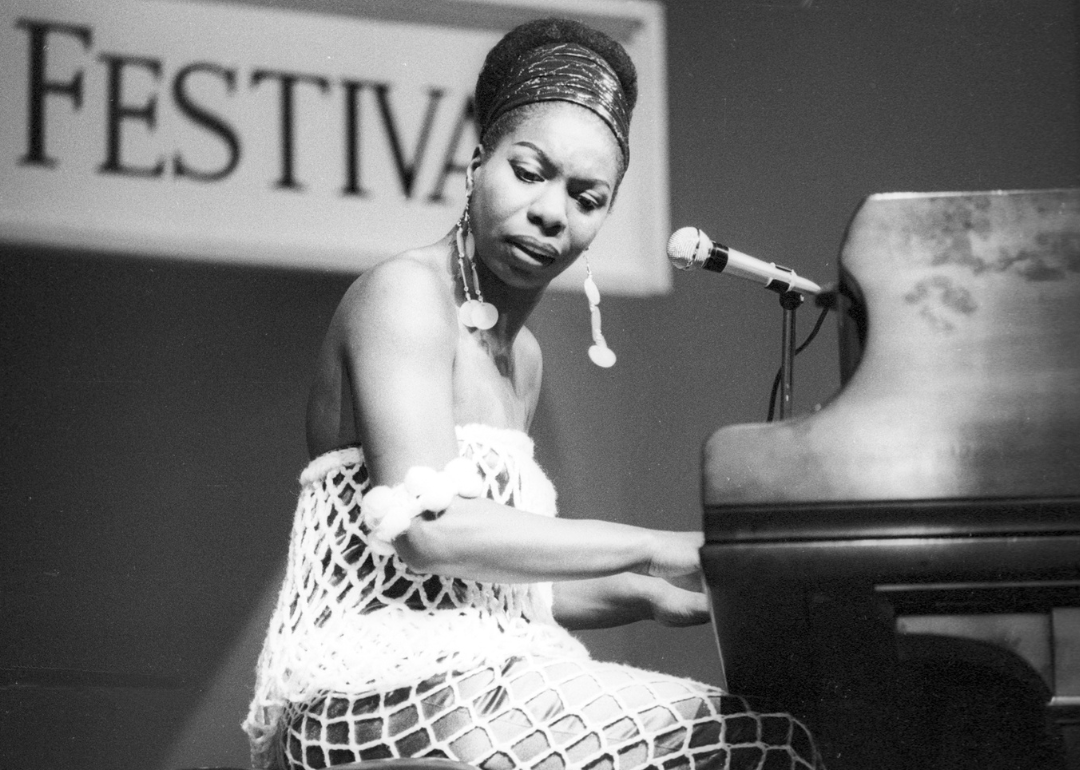
Tom Copi/Michael Ochs Archives // Getty Images
Soundtrack of the revolution: Songs of the ’60s and ’70s that played a role in political movements
Nina Simone performing at Jazz Festival.
More than half a century ago, a prominent portion of the music that found popularity in mainstream America achieved it through what feels almost antithetical to the concept of “popular” music. Some of the most beloved and listened to songs of the time came from varied factions of the counterrevolution, or were adopted as anthems of this movement, produced by a group of progressive, anti-war, anti-racism, anti-sexism, and sex-positive rebels who spent a large part of the decades fighting for the things they believed were right.
This was a time when people were living—and in some instances dying—for their causes. From the Kent State shooting in 1970 where the Ohio National Guard killed four students under the guise of dispersing a crowd of student demonstrators, to the Chicago Seven (or Eight) trial mere months before in 1969, which attempted to prosecute anti-war protesters for inciting a riot. These situations, and the times in general, were punctuated by the assassinations of leaders such as Malcolm X, Medgar Evers, Martin Luther King Jr., and Fred Hampton, among others—all of which left an indelible mark on the landscape of society.
From the Civil Rights Movement of the 1950s and ’60s to the Black Lives Matter movement of today, the farm workers’ strikes by Chicano and Filipino laborers in the ’70s to the same fight and strikes more than five decades later, the struggles continue. Through it all, music has been an indelible way to carry the messages of the time, so much so that many of the songs on this list are still used in political movements today.
Music has consistently shown that it has the power to unify and unite a collective in the moment, as well as a successful method to convey messages in a simple but effective way that resonates with a majority. For whatever reason it was used, music has consistently acted as a means to an end for communicating the complicated political context of the issues at hand through a filter of emotion, care, and inspiration—all while being catchy enough to get stuck in people’s heads.
Using various sources—including historical documents from the movement, online archives, and various websites—Stacker has compiled a list of songs and artists that personified, inspired, or played a role in the political movements of the 1960s and ’70s. Some of the songs below may be ones you recognize not only from their original iterations but in protests to this day. Scroll through and see how many you know.
![]()
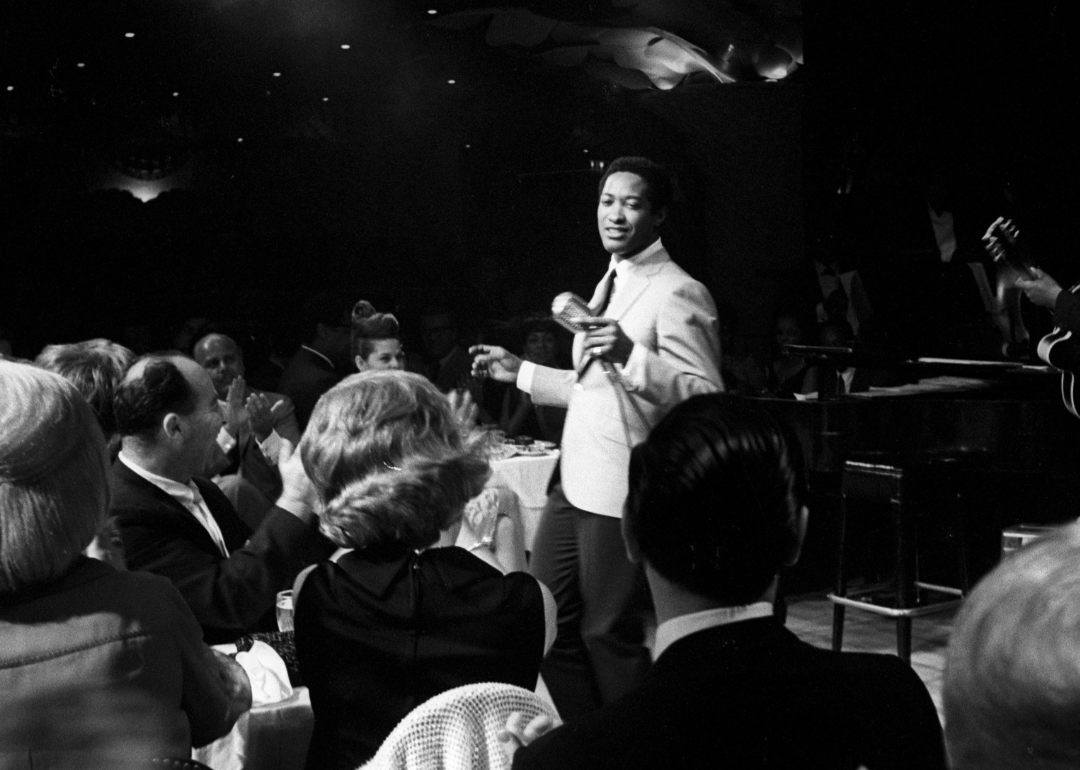
Ben Martin // Getty Images
‘A Change is Gonna Come’ by Sam Cooke
Sam Cooke performing at the Copacabana nightclub.
The brief but brilliant career of singer Sam Cooke featured a myriad of songs that continue to be popular to this day, but it was his 1964 classic “A Change is Gonna Come” that became one of his most beloved—and one of the unofficial anthems of the radical movements of the ’60s. It was also one of the last songs Cooke recorded before he was murdered in a Los Angeles motel. Moved to write a protest song that could also climb the charts (like Bob Dylan’s “Blowin’ in the Wind”), Cooke would pen the anthem and infuse it with a sense of urgency that could only come from someone who has lived the problem and continues to press on.
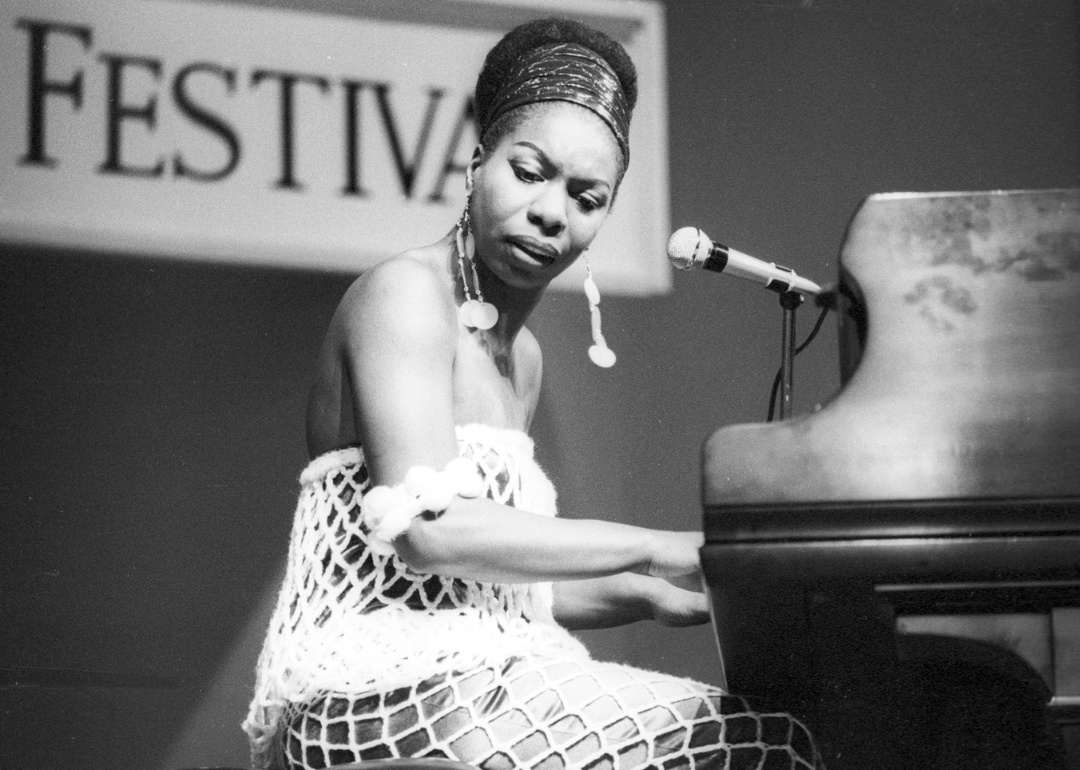
Tom Copi/Michael Ochs Archives // Getty Images
‘Mississippi Goddam’ by Nina Simone
Nina Simone performing at Jazz Festival.
Not long after the murder of Civil Rights leader Medgar Evers, Nina Simone released the raucously energetic “Mississippi Goddam” into the world. Despite the song’s danceable beat, the lyrics told a darker tale. That quick tempo somehow falls in line with the syncopated rhythms of the listener’s heartbeat. The energy feels reminiscent of fear as Simone sings about the “hound dogs” on her back that never seem to go away and never knowing if today is the last day—a story that is all too familiar for many of the leaders within the movements both then and now.
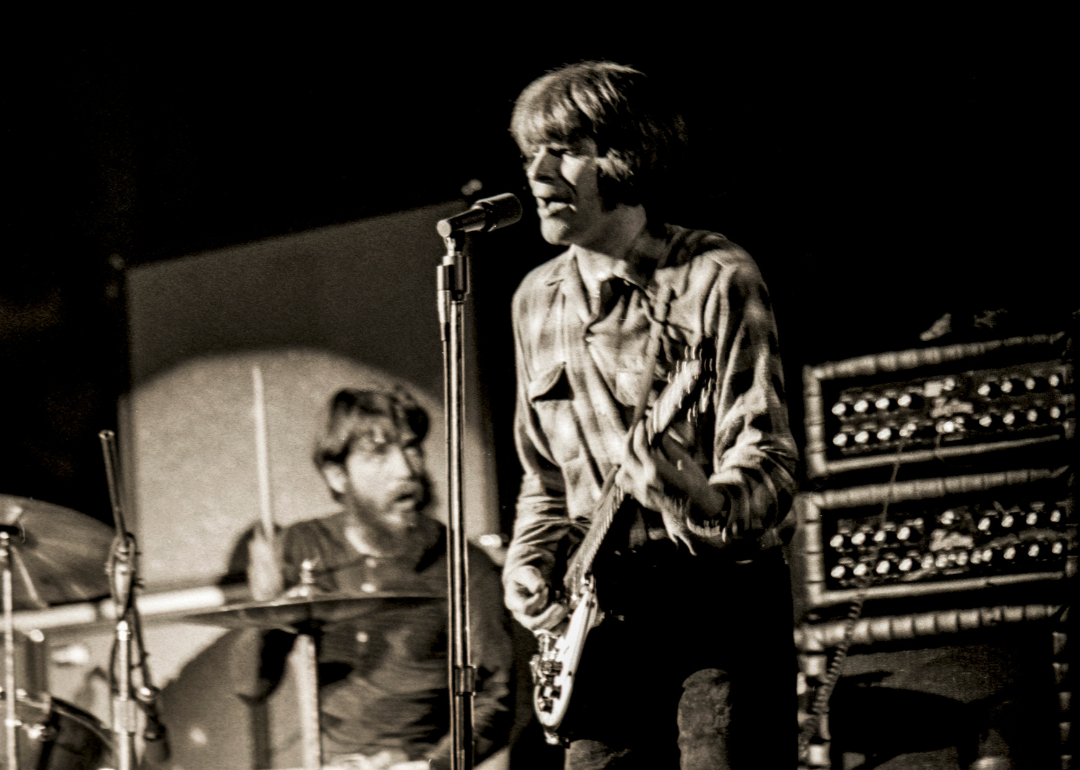
Jeff Hochberg // Getty Images
‘Fortunate Son’ by Creedence Clearwater Revival
Creedence Clearwater Revival performing on stage.
A band that will appear on this list more than once for their powerful anti-war, anti-establishment ideals is Creedence Clearwater Revival, the John Fogerty-led swamp rock group who gave us such classics as “Run Through The Jungle” and 1969’s “Fortunate Son” which spoke to the frustrations Fogerty felt over the military draft during the Vietnam War. On top of the anti-war themes, CCR also touched on the apparent favoritism faced by the sons of the politicians and decision-makers who were sending troops to war in the first place.
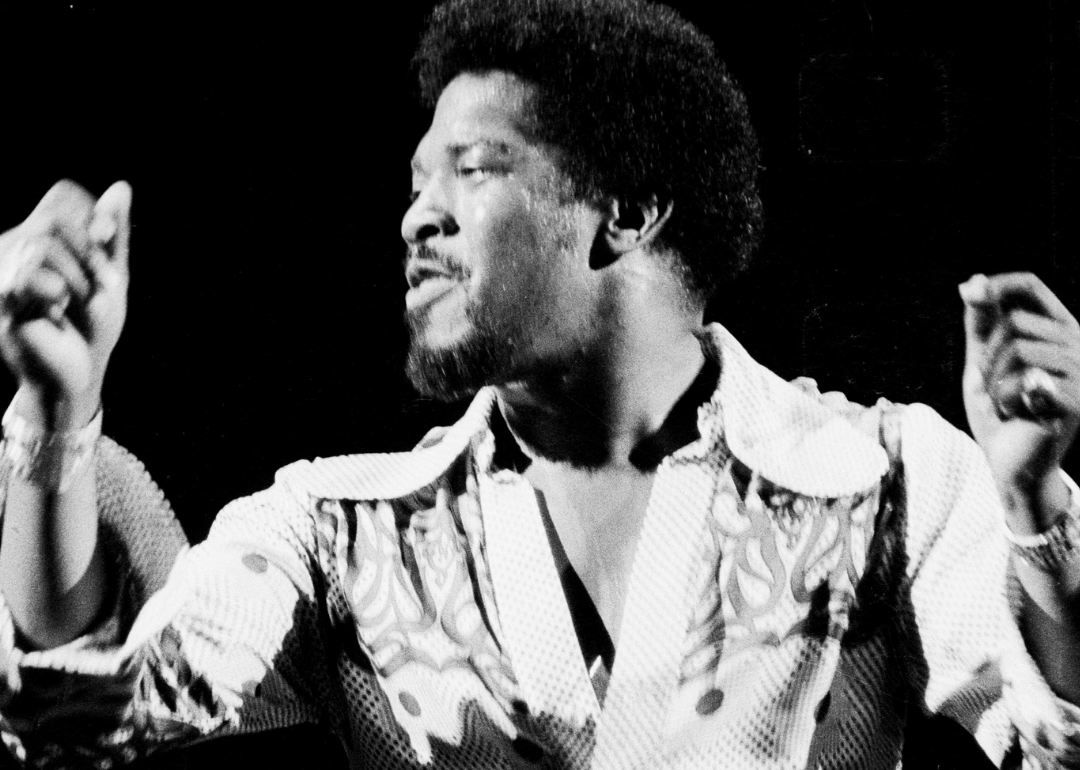
Michael Putland // Getty Images
‘War’ by Edwin Starr
Edwin Starr performs on stage.
The transition from the ’60s to the ’70s seemed perfectly personified by the 1970 single by Edwin Starr, “War,” which was quickly picked up by the anti-war movement. The powerful chorus features a multitude of voices chanting “war” and “what is it good for?” as Starr translates his anger, frustration, and pain into his refrains. Despite being widely popular and relevant for anti-war or anti-military movements, Starr would lament that the song’s true meaning got lost. “The song was never about the Vietnam War,” he told British paper The Voice in 2001. “It was about the neighborhood wars and the racial wars that were going on inside America at the time. It just happened to coincide with the war in Vietnam.”
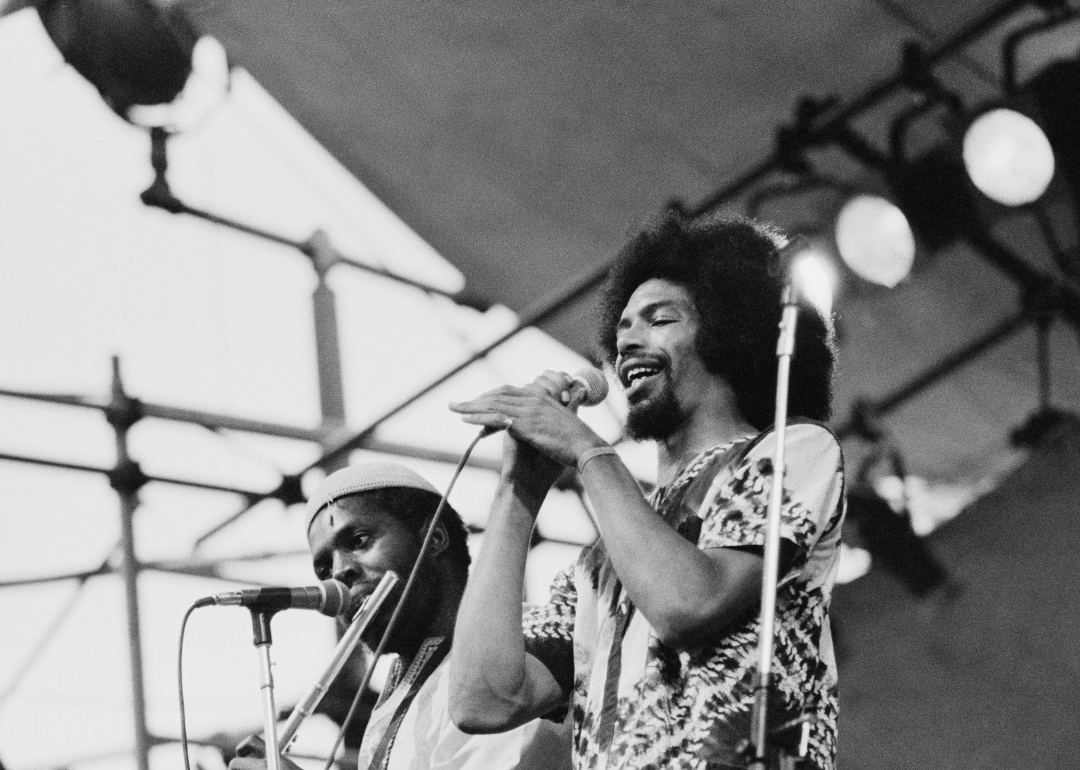
David Redfern/Redferns // Getty Images
‘The Revolution Will Not Be Televised’ by Gil Scott-Heron
Gil Scott-Heron performing on stage.
A phrase. A mantra. A slogan. Call it what you will, but with Gil Scott-Heron’s jazz poetry fusion “The Revolution Will Not Be Televised,” the writer, musician, and activist elevated a phrase that would become one of the most powerful messages of the counterrevolution—one that still carries weight in modern-day political movements.
Added to the National Registry of the Library of Congress in 2005, the song acts as a blatant call to action that nothing will change if you sit as a passive observer—the revolution requires action. Considering Heron was only 19 at the time he wrote it and one of three children to integrate his middle school in Tennessee in 1961, it was clear Scott-Heron lived by the mantra he preached and wrote the song that would resonate with the masses for generations.
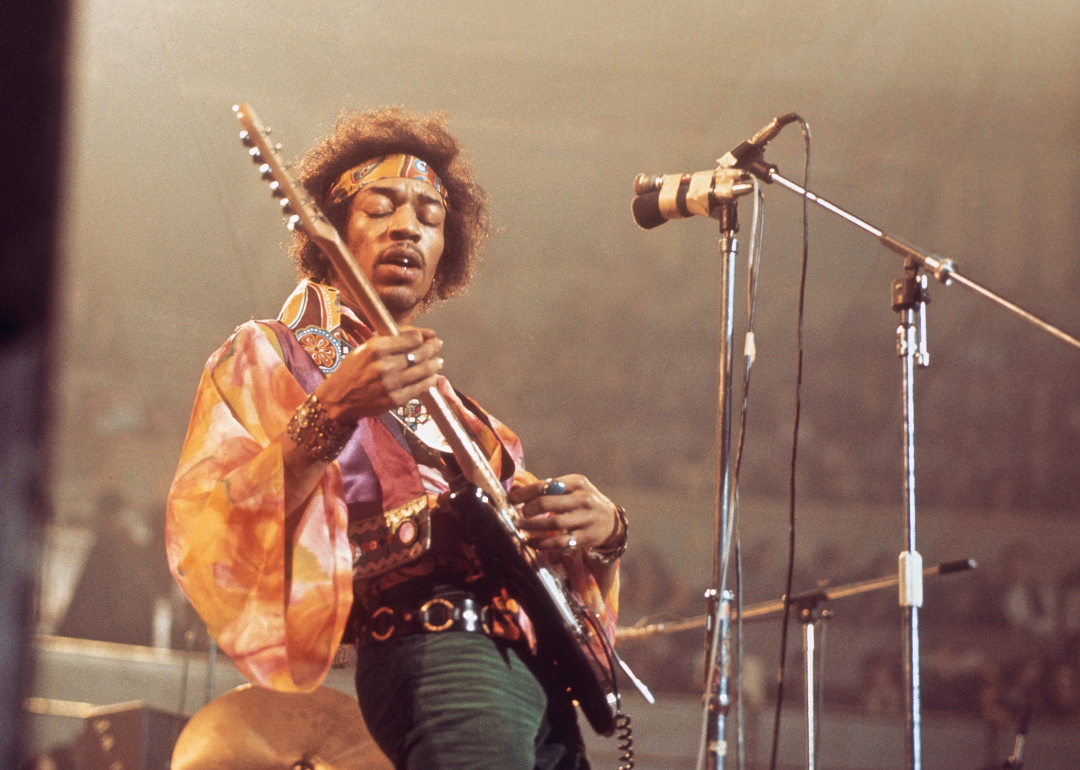
David Redfern/Redferns // Getty Images
‘All Along the Watchtower’ by The Jimi Hendrix Experience
Jimi Hendrix performing at The Royal Albert Hall.
Originally written by a repeat writer on this list (Bob Dylan), Jimi Hendrix’s powerful interpretation has maintained a heavy rotation on people’s playlists. The anti-establishment messaging, crunchy and electric guitar riffs provided by Hendrix, and the powerful contrast to Dylan’s soft-spoken folk version turned this into a hard rock classic. The single peaked at #20 on Billboard’s Hot 100 chart and remained on the charts for nine weeks, proving that the mainstream listener was hungry for something more than the saccharine boy bands wanting to hold your hand.
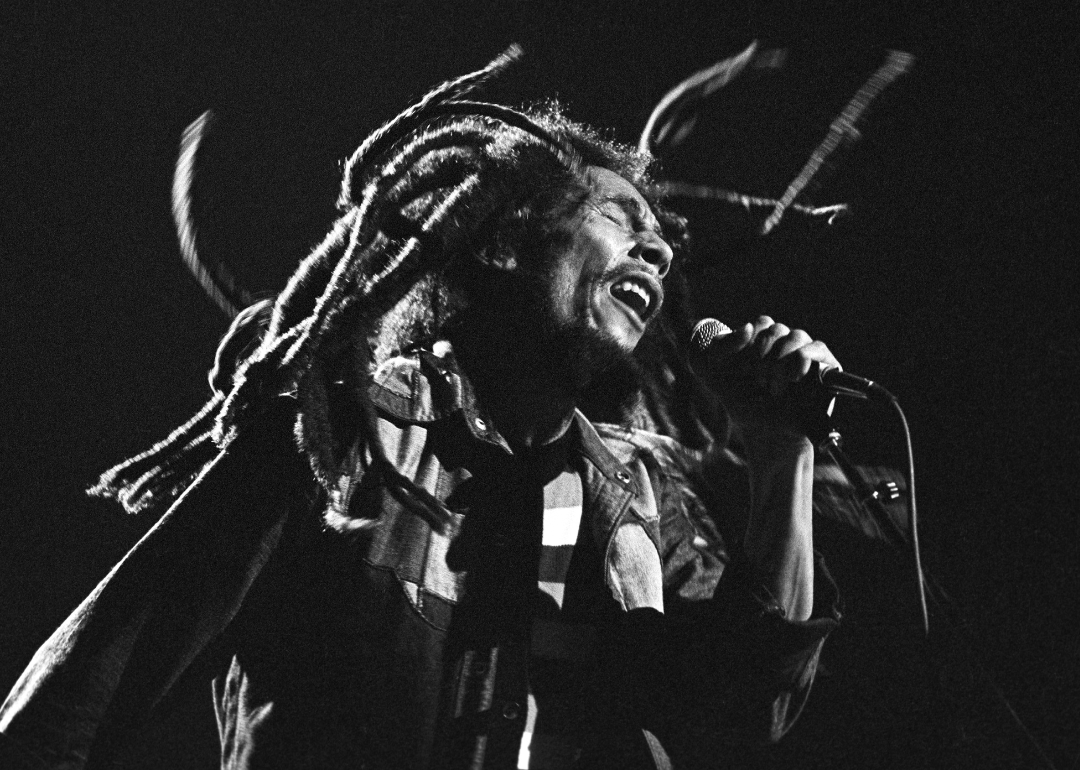
Kirk West // Getty Images
‘Get Up, Stand Up’ by Bob Marley and The Wailers
Bob Marley and the Wailers perform at the Uptown Theater.
A song that puts it all out there right in the title is Bob Marley and The Wailers’ “Get Up, Stand Up,” which was written alongside Peter Tosh as a call to action to fight against oppression, which was inspired by Marley’s own life experiences in Jamaica, as well as his travels to other countries. The song’s somewhat militant message managed to take hold of the hearts and minds of counterrevolutionaries around the world and is still considered a relevant political anthem to this day.

John Byrne Cooke Estate // Getty Images
‘Time Has Come Today’ by The Chamber Brothers
The Chambers Brothers perform at Newport Folk Festival.
There are few songs that feel more memorable thanks to the repetitive “TIME!” that is screamed throughout The Chamber Brothers’ 1967 classic “Time Has Come Today.” While the lyrics were vague and almost cleverly ambiguous, the constant call to action repeated throughout the song allowed it to resonate with various counterculture movements of the ’60s and ’70s.
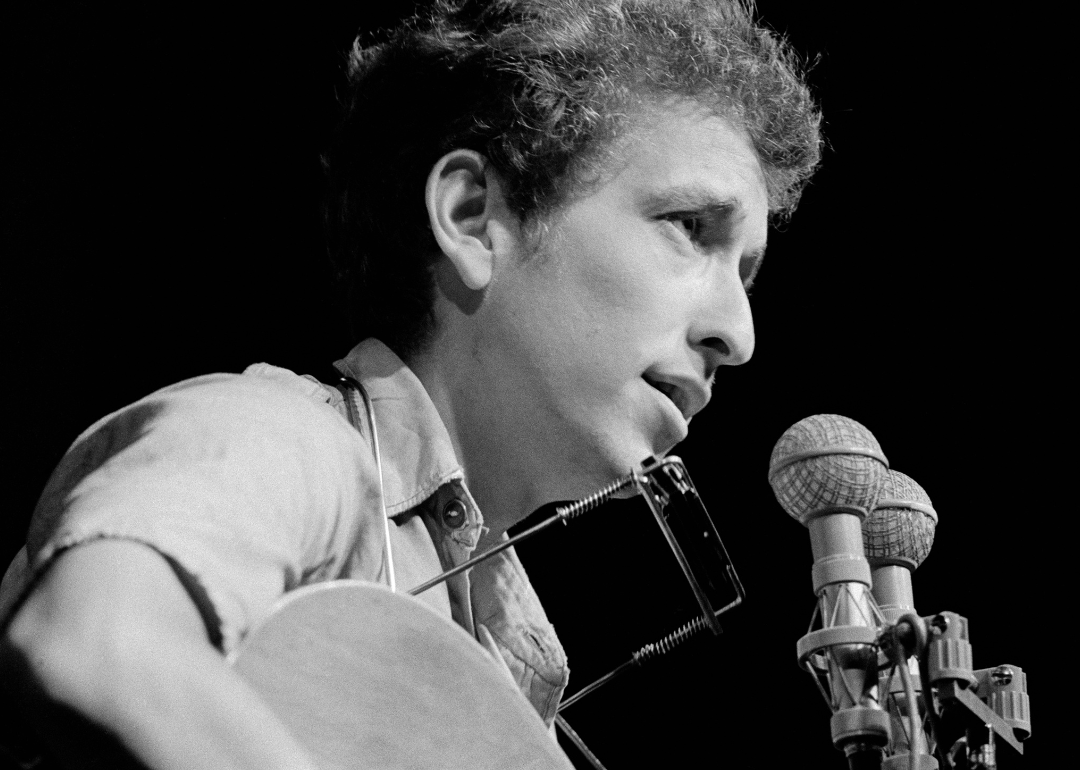
Rowland Scherman // Getty Images
‘Blowin’ in the Wind’ by Bob Dylan
Bob Dylan at the Newport Folk Festival.
Another seminal classic in the political song oeuvre of the ’60s was “Blowin’ in the Wind”—written by Bob Dylan and performed by both him and the group Peter, Paul and Mary—a song whose foundation was pulled from a Negro spiritual entitled “No More Auction Block.” While the Dylan and PP&M versions spoke to the same messages as the spiritual, the song was adopted more by the anti-war movement of the time, though the lyrics featured layers that alluded to sentiments against war, segregation, and racism.
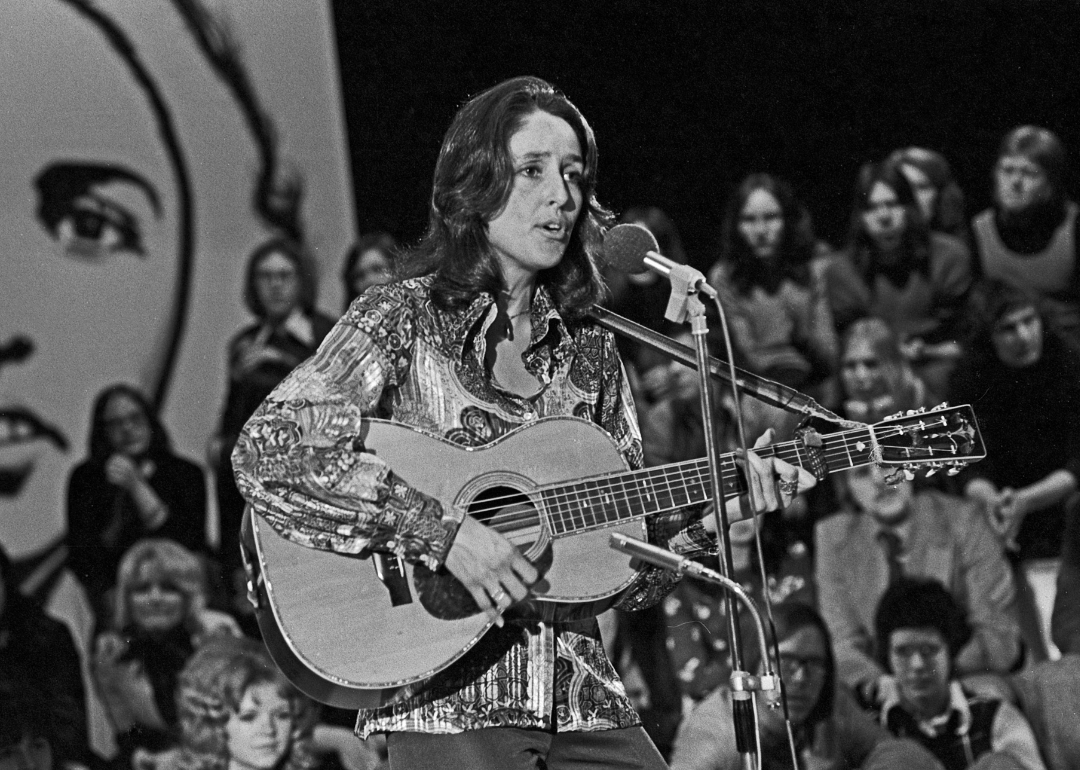
Helmut Reiss/United Archives via Getty Images
‘The Night They Drove Old Dixie Down’ by Joan Baez
Joan Baez performing on stage.
It’s a song where the title truly says it all in terms of what the message is. Originally released by Canadian American rock group The Band, the cover by the iconic Latina folk singer and activist Joan Baez managed to take a special hold during the ’70s. The song was sung as a narrative recounting the downfall of the South during the Civil War and seemed to act as an audible reminder that evil, in whatever form, could be defeated if enough people stood up and fought.
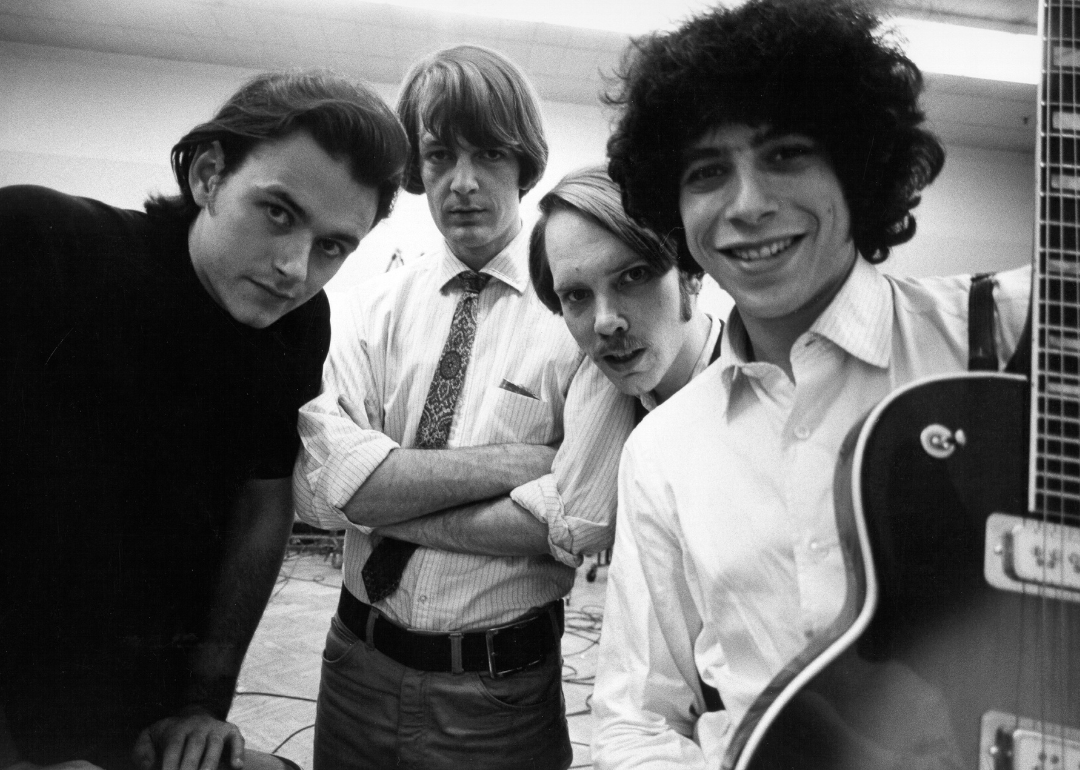
Michael Ochs Archives // Getty Images
‘Get Together’ by The Youngbloods
Members of the band The Youngbloods pose for a portrait.
“Get Together” by The Youngbloods blended folk sensibilities with psychedelia to create a shiny, happy people sort of protest song. The lilting lyrics melded with the gently harmonious tones of lead singers Jesse Colin Young and Jerry Corbitt to create a sort of give-peace-a-chance-like state as they called for listeners to come together in unity and solidarity across all manners of divisions. The song was seminal for the peace movement at the time and has since been sampled in multiple iterations throughout the decades—with artists like Nirvana using the refrain for their song “Territorial Pissings” in the early ’90s.
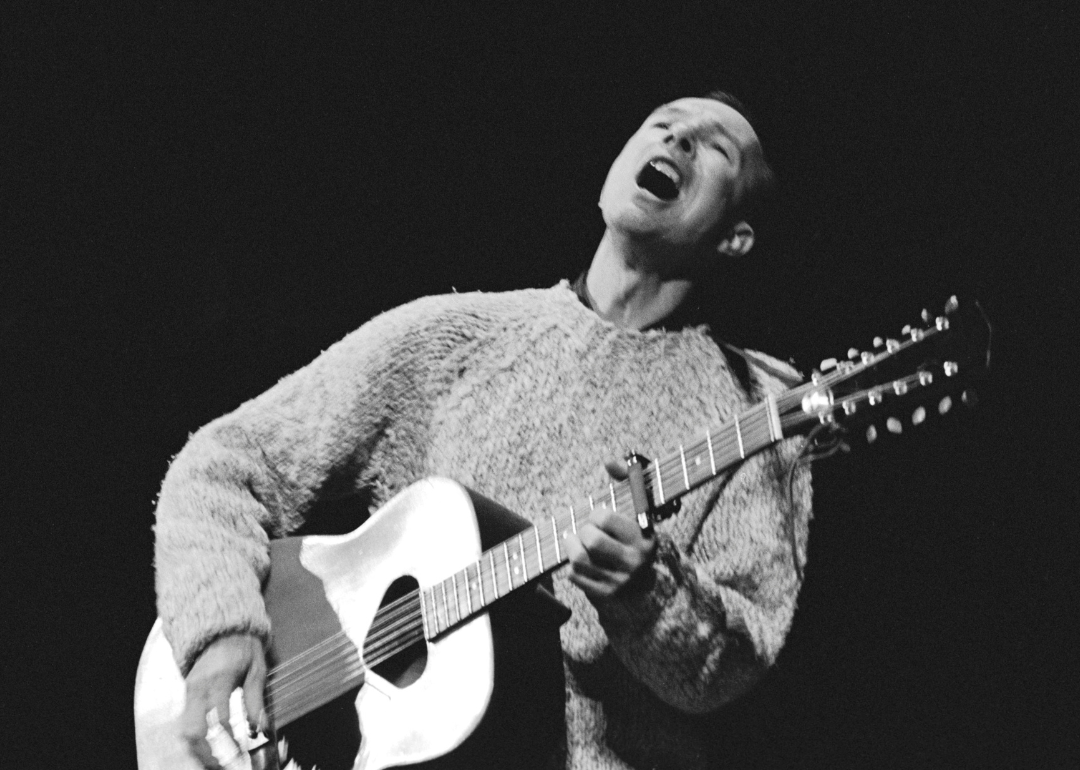
Brian Shuel/Redferns // Getty Images
‘We Shall Overcome’ by Pete Seeger
Pete Seeger performing at a concert in honor of Paul Robeson.
Pete Seeger’s “We Shall Overcome” was used quite often in the Civil Rights Movement of the ’60s and ’70s, but it wasn’t the first time that political movements heard the song make its way through the lips of protesters all across the nation. The first appearance of the hymnal song came in the ’40s during the labor strike against American Tobacco in South Carolina, when workers went on strike in order to achieve higher pay than what they were offered.
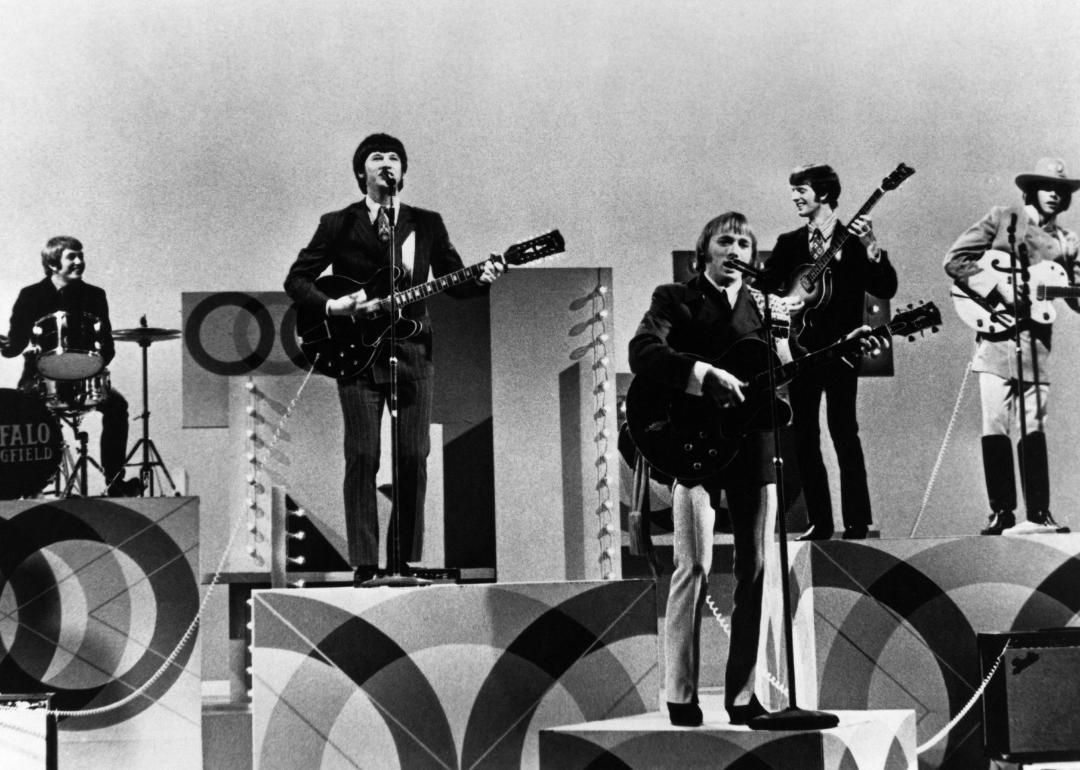
Charlie Gillett/Redferns // Getty Images
‘For What It’s Worth’ by Buffalo Springfield
Neil Young, Stephen Stills, and Buffalo Springfield performing on stage.
Another prime example of mainstream audiences embracing the messaging of the counterculture movement is Buffalo Springfield’s 1966 single “For What It’s Worth,” written by Stephen Stills, who would later form Crosby, Stills, Nash & Young. Its political underpinnings landed the song in the top 10 of Billboard’s Hot 100 but held a strongly anti-establishment slant. The lyrics were inspired by the Sunset Strip Curfew Riots of the ’60s.
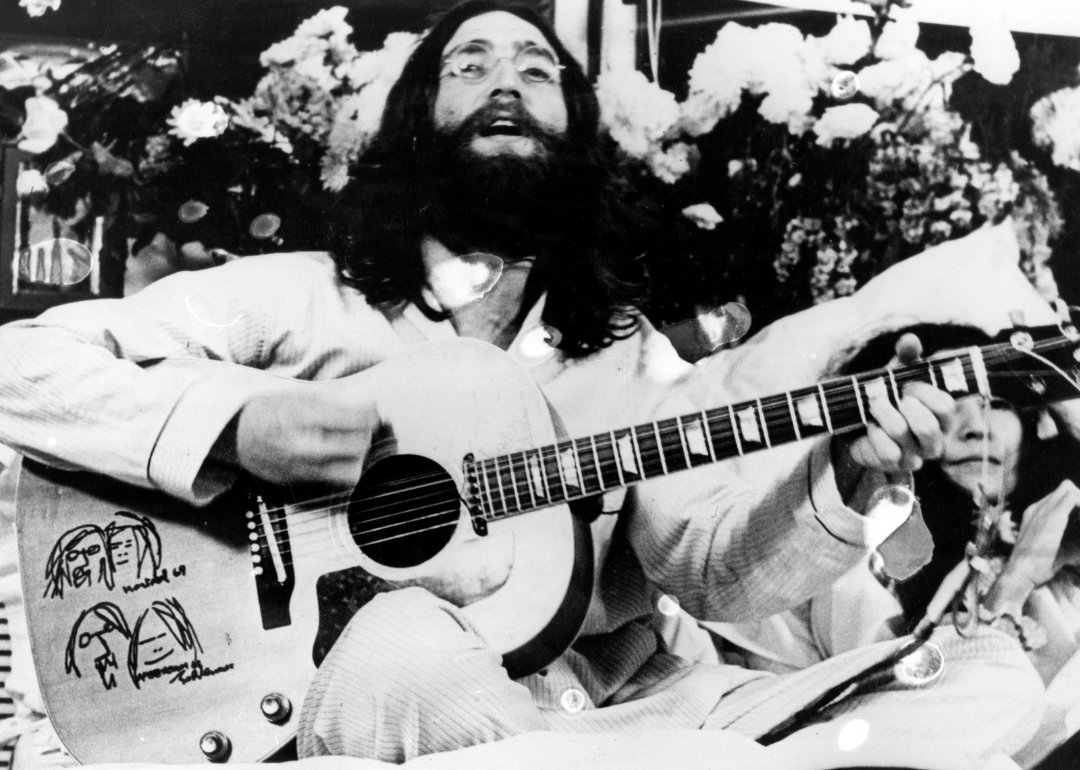
Keystone Features // Getty Images
‘Give Peace a Chance’ by the Plastic Ono Band
John Lennon and Yoko Ono playing music during bed in.
John Lennon and Yoko Ono have caused quite a few controversies over the course of their relationship—including the anti-war, pro-peace stance much of their music took when they worked together. One such example is the hit single “Give Peace a Chance,” released on July 4, 1969 (in the U.K.) and July 7 (in the U.S.). It was Lennon’s first single without the backing of other Beatles. The phrase that became the song’s title was first uttered by Lennon during his and Ono’s infamous “bed-in” protest and seemed to give the song flight.
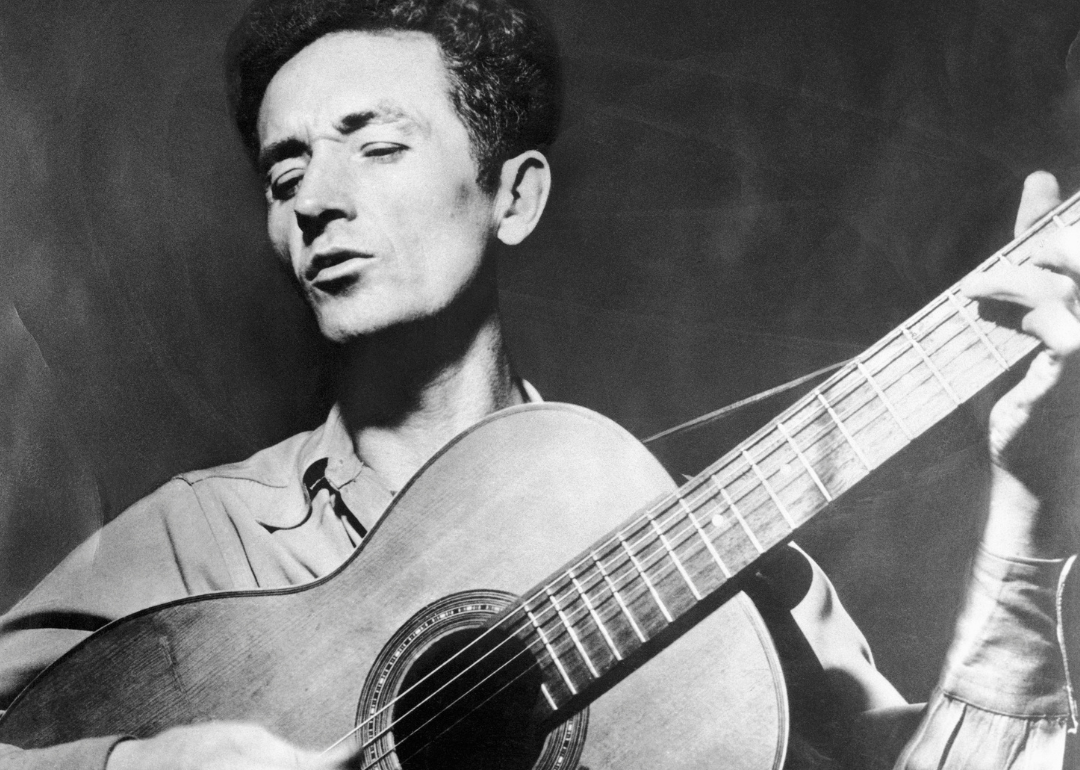
Bettmann Archive // Getty Images
‘This Land Is Your Land’ by Woody Guthrie
Woody Guthrie playing the guitar.
Written in 1940 by Woody Guthrie, “This Land Is Your Land” was written as a response to the Irving Berlin song “God Bless America.” Guthrie had been consistently exposed to the tune while traveling across the United States, and its message increasingly annoyed him. In response, “This Land Is Your Land” speaks to the overwhelming and unnecessary wealth held by an infinitesimally small portion of society in the U.S. and the gross disparity between the wealthy and the rest of the country.
The song held a special place during the Civil Rights Movement and remains relevant today. Most recently, the song was sung by Tom Morello from Rage Against the Machine as he stood in solidarity with California farmworkers during a 2022 push for a pro-collective organizing bill to be passed.
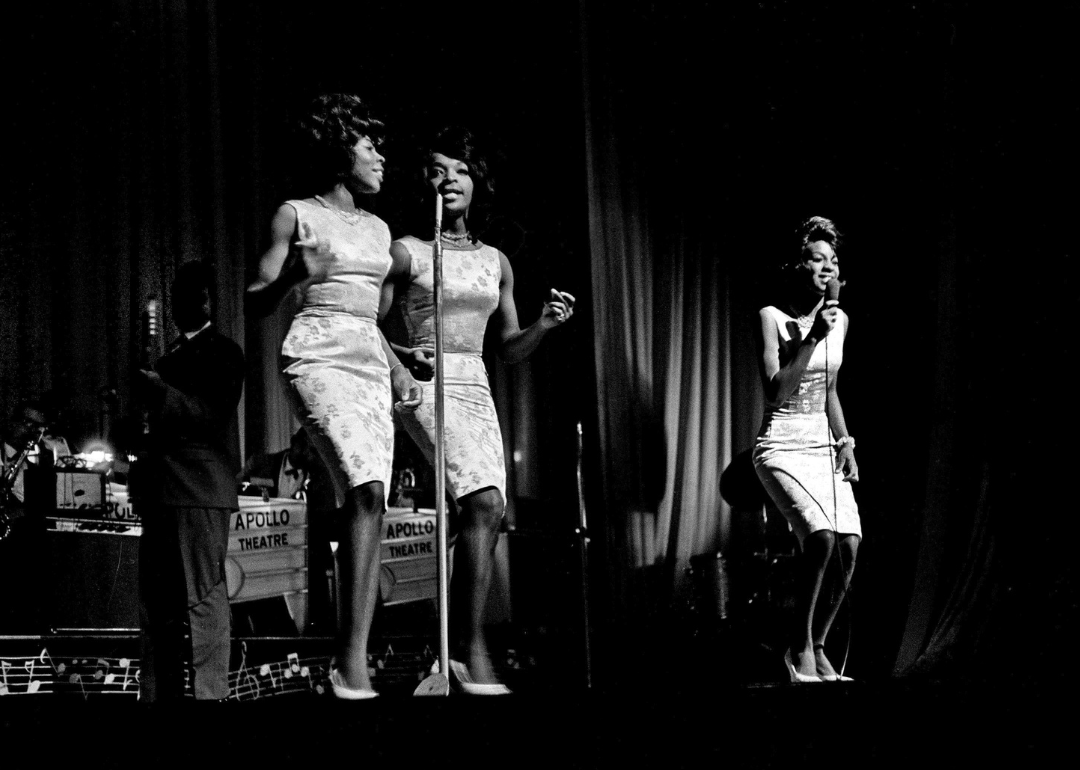
Don Paulsen/Michael Ochs Archives/Getty Images
‘Dancing in the Street’ by Martha Reeves and The Vandellas
Martha And The Vandellas performing at The Apollo.
Although not explicitly intended as a protest song, the call-to-action style lyrics of “Dancing in the Street” resonated with activists and freedom fighters across the country—especially the song’s specific mention of cities that were known for unrest within marginalized communities such as Chicago, Baltimore, Motor City (Detroit), and Philadelphia. All of these cities had high populations of Black and Brown residents. The song unintentionally became associated with the Civil Rights Movement and was used as a call to action for many at the time.
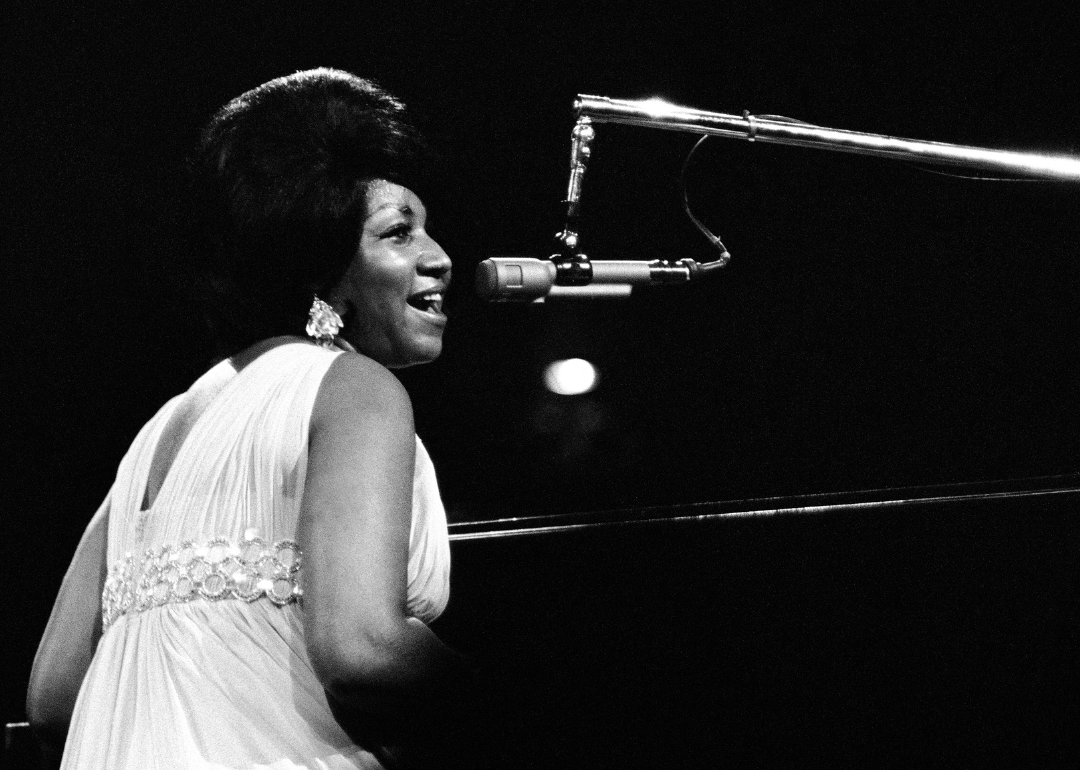
Jack Robinson // Getty Images
“Respect” by Aretha Franklin
Aretha Franklin plays piano as she performs on stage during the ‘Soul Together’ Concert.
Over the course of the Queen of Soul’s career, Aretha Franklin’s music has permeated generations, with hits spanning decades. Yet there are few that have made as much of an impact as her first #1 hit, “Respect,” a song that managed to play dual roles in both the feminist movement and the Civil Rights Movement with its message of empowerment for both women and Black women in particular to demand respect—from men, from white people, from whomever the message could be directed to. The universality of the lyrics allowed it to morph and shape around a variety of causes.
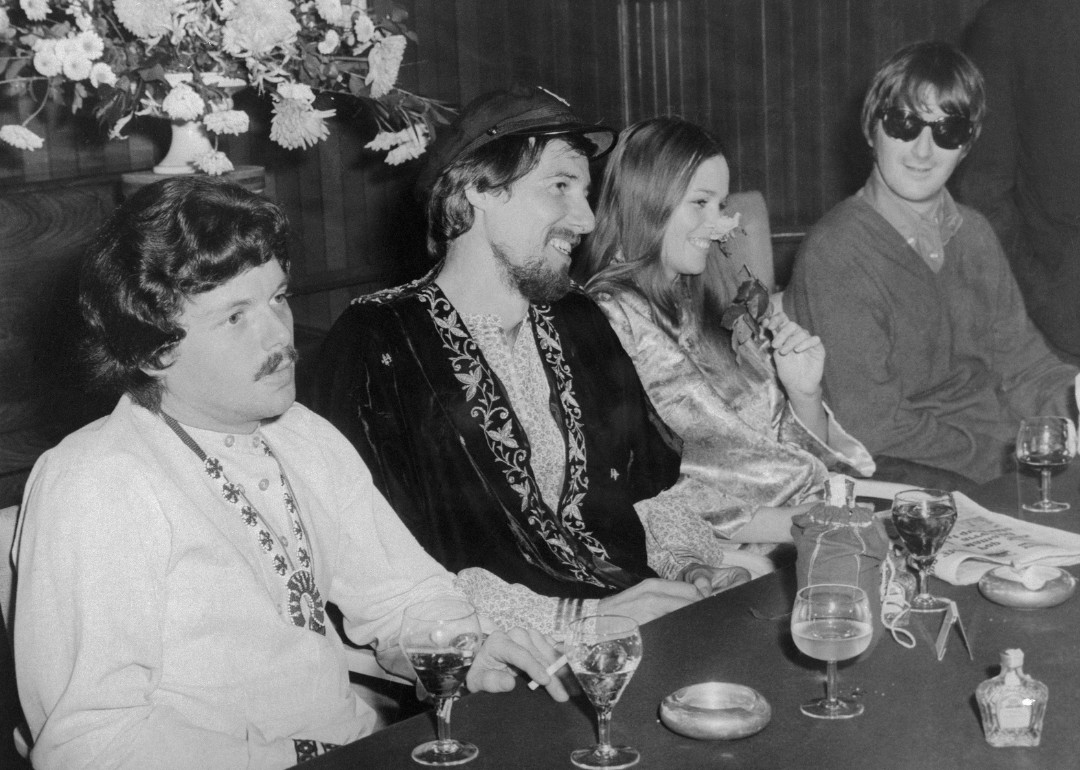
Bettmann Archive // Getty Images
‘San Francisco (Be Sure to Wear Flowers in Your Hair)’ by Scott McKenzie
Members of The Mamas and the Papas and Scott McKenzie giving a press conference.
Originally written by John Phillips (lead singer of ’60s group the Mamas & the Papas) with the vocals sung by Scott McKenzie, the song was not only beloved for capturing the spirit of the counterculture, especially in Northern California, but it has found its way into multiple movie soundtracks set during the ’60s and ’70s, including the box office smash and Oscar-winning “Forrest Gump.” The song has been adapted by hip-hop artists such as San Francisco rapper San Quinn, turning the original meaning to speak more towards the modern era of gentrification in the city.
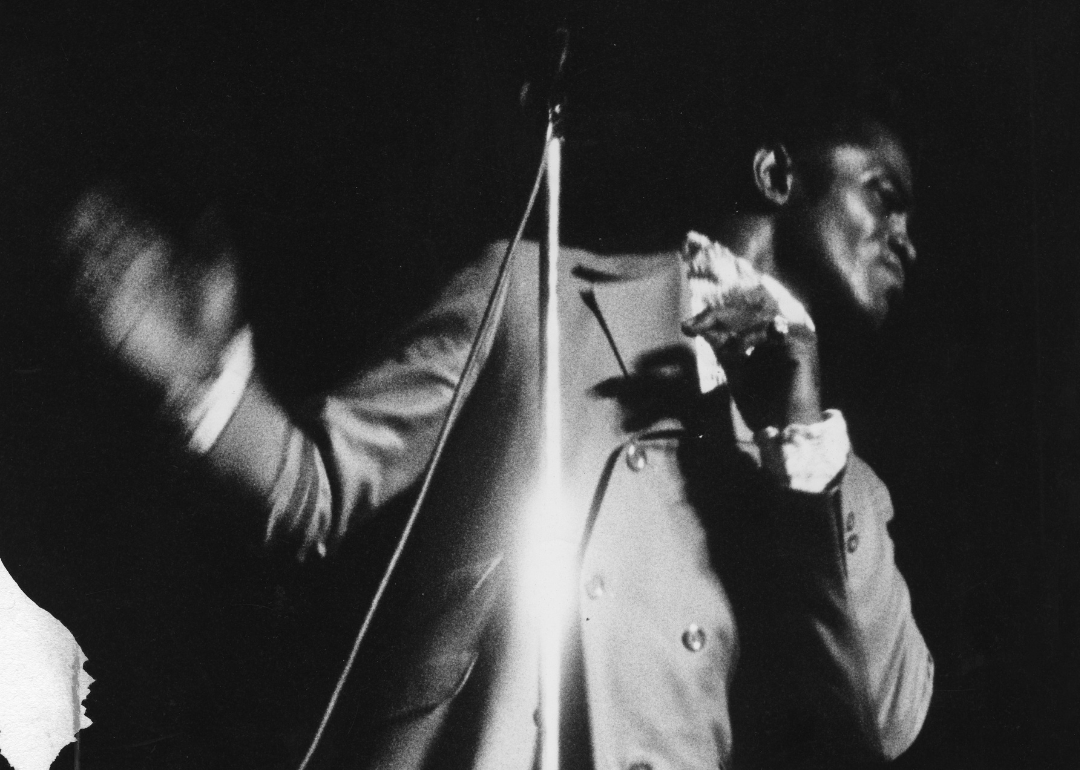
Gilbert E. Friedberg/The Boston Globe via Getty Images
‘Say It Loud – I’m Black and I’m Proud’ by James Brown
James Brown performing on stage.
Few songs have captured the attention of both the Billboard charts and a mass movement so much as James Brown’s 1968 hit “Say It Loud – I’m Black and I’m Proud,” released four months after the assassination of Martin Luther King Jr. rocked the world. Brown, also known as the Godfather of Soul, seemed to take the pain, anguish, and anger that many were feeling and somehow transpose it into a powerful expression of pride that gripped the nation and the charts.
The song climbed to #1 on the R&B charts and remained there for six weeks while simultaneously peaking at #10 on the Billboard Hot 100. The song is still considered a powerful and beloved anthem to this day and is often used as a chant or protest song.
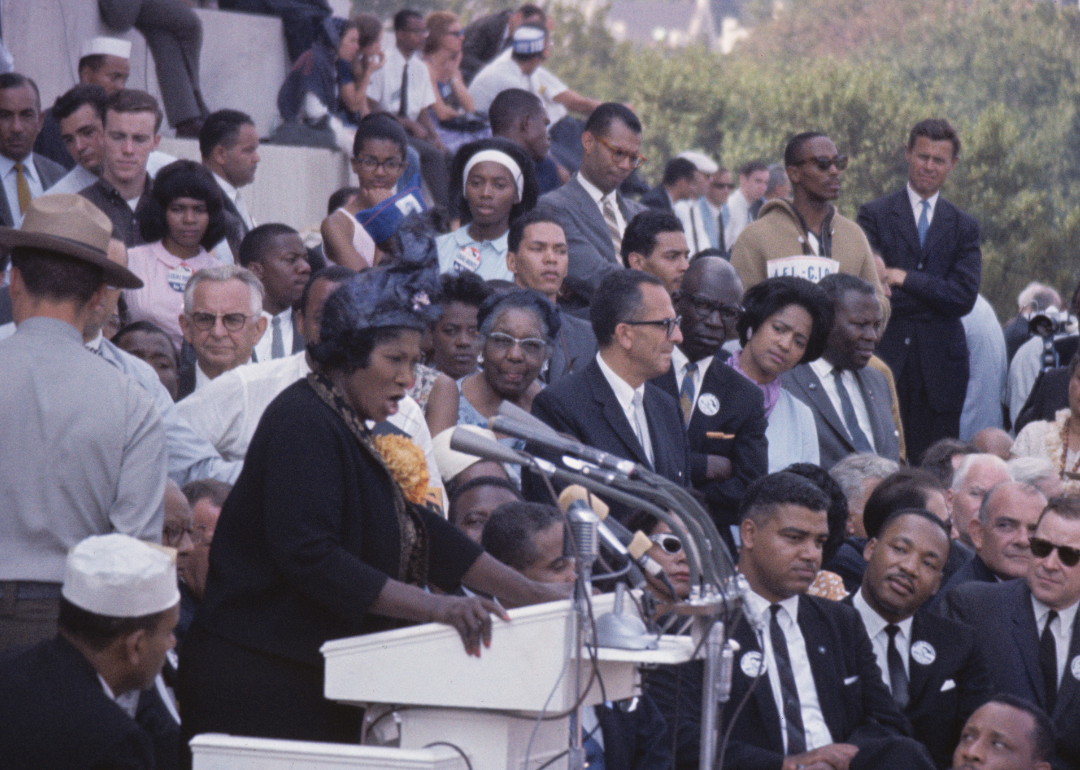
Bob Parent // Getty Images
‘How I Got Over’ by Mahalia Jackson
Mahalia Jackson sings on the steps of the Lincoln Memorial.
There are few artists who seemed to have as big of an impact on the movement as it pertained to MLK than soul singer Mahalia Jackson. The powerful songstress was on the dais during 1963’s March on Washington, singing “How I Got Over” to set the tone for the infamous “I Have A Dream” speech by Martin Luther King Jr.
The singer was as impactful as her song. It was Jackson’s repeated call to Dr. King (“Tell ’em about the dream, Martin.”) that inspired the Civil Rights leader to cast aside his notes and extemporaneously give the world the speech that would reverberate through the decades. “I have a dream…” The song and the moment are inextricably linked for the rest of time.
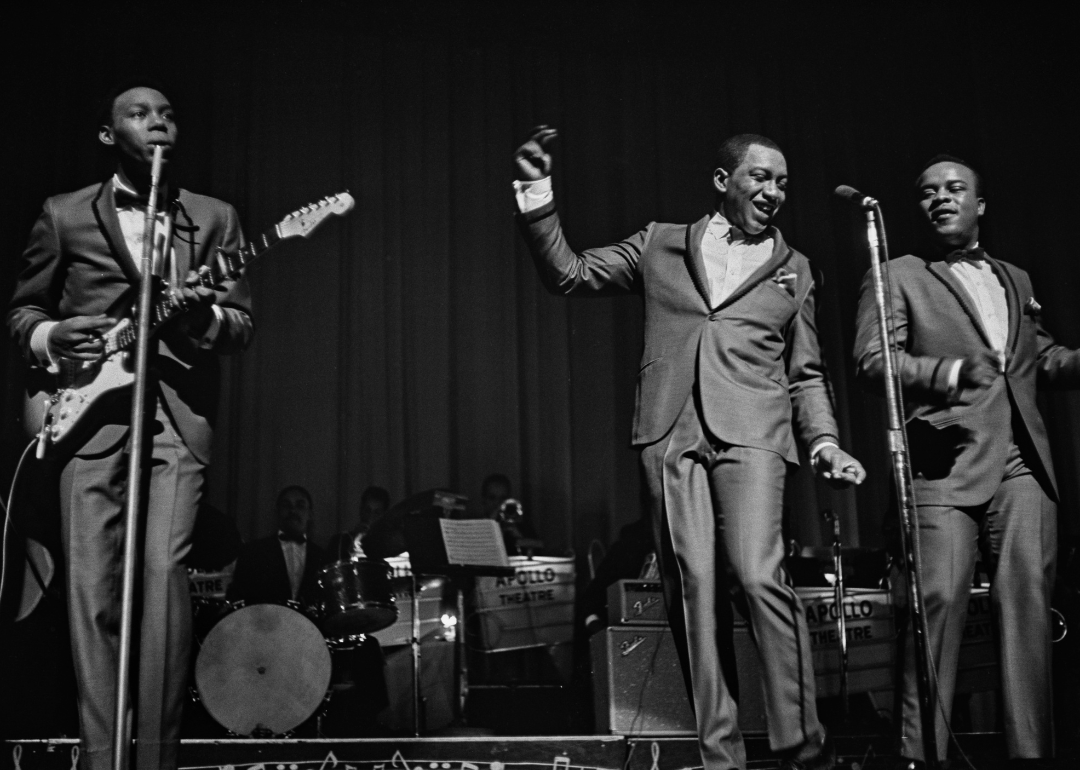
Don Paulsen/Michael Ochs Archives/Getty Images
‘People Get Ready’ by The Impressions
The Impressions play The Apollo.
Officially added to the National Registry in 2015, the 1965 song “People Get Ready” by The Impressions was chosen as the unofficial anthem of the Civil Rights Movement by Martin Luther King Jr. The song played on secular themes and had lyrics embedded with meaning—primarily the atonement that never came for the crimes against humanity perpetrated during the time of slavery. Beyond the special place it held with the movement, the single—which was written by Curtis Mayfield—made its way throughout Chicago church songbooks and reached #3 on the Billboard R&B chart, as well as #14 on the Billboard pop chart at the time of its release.
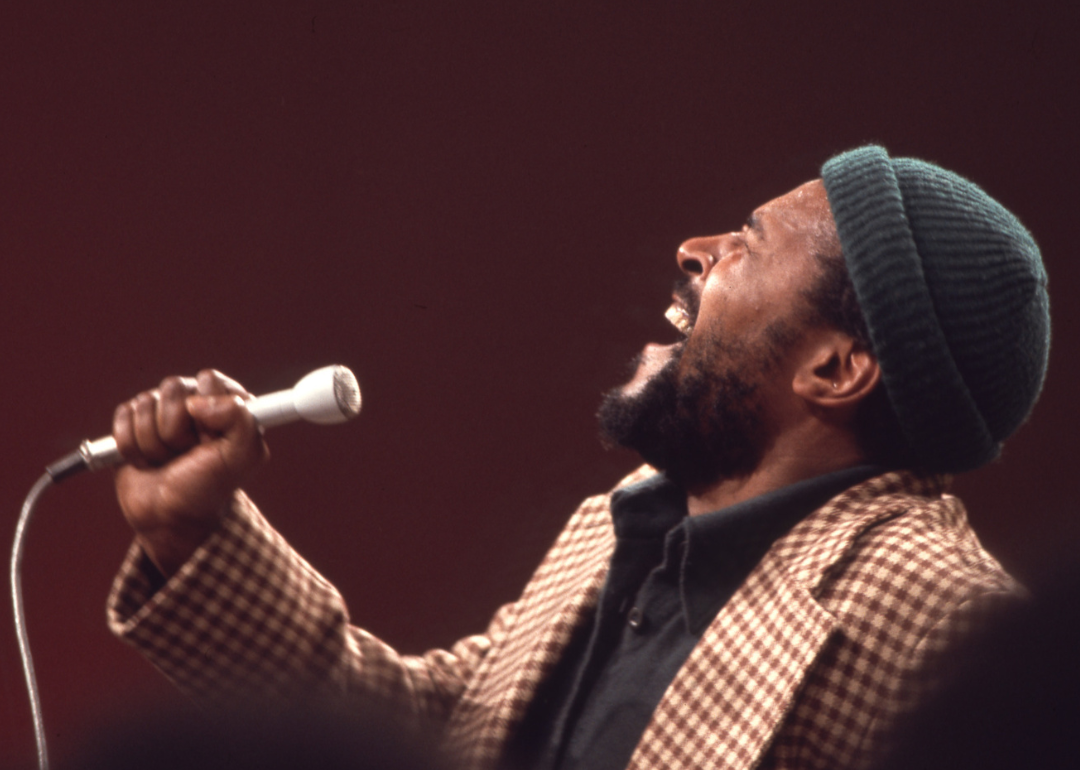
Soul Train via Getty Images
‘Inner City Blues’ by Marvin Gaye
Marvin Gaye performs on Soul Train.
Covered and sampled by Gil Scott-Heron and A Tribe Called Quest, among more than 100 others, Marvin Gaye’s “Inner City Blues” is another shining example of a song that has continued to carry weight. Its prescient lyrics speak to the idea that freedom is a constant struggle. It also pointed to the incredible spending the government could spend on things like sending a man to the moon, but the poorer neighborhoods in Detroit were often without food and water. As we have carried into the modern era, the song continues to feel all too relevant as the Flint, Michigan, residents continue to grapple with the city’s water crisis to this day.
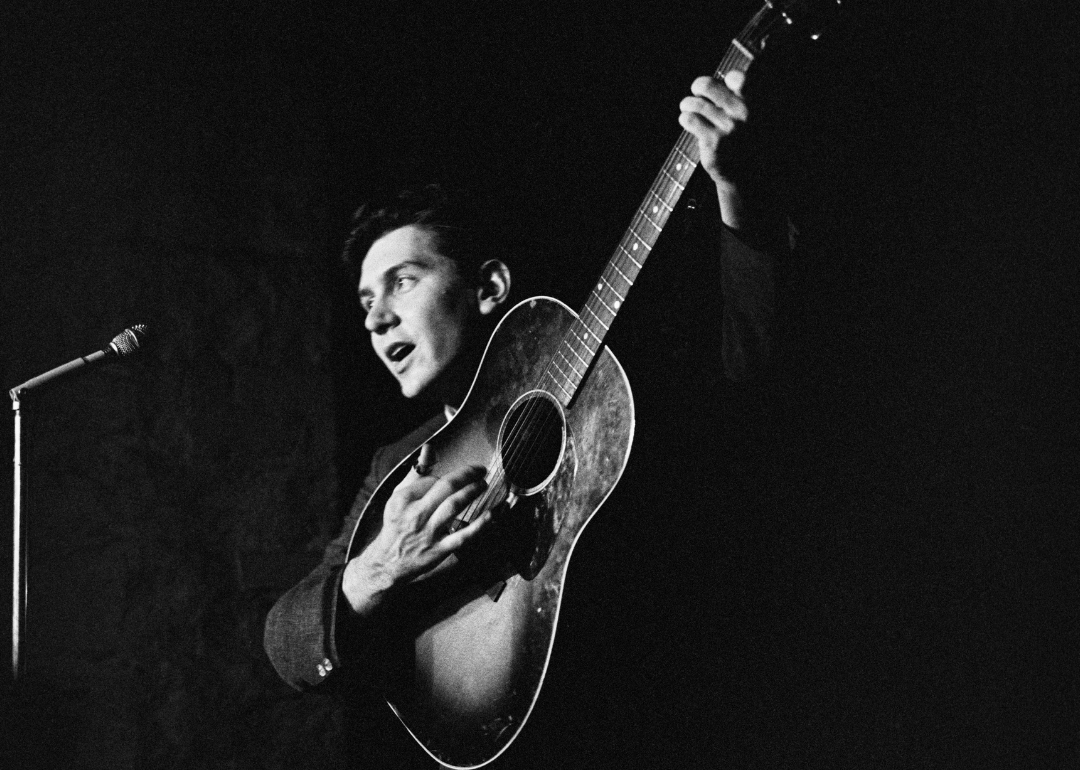
Don Paulsen/Michael Ochs Archives // Getty Images
‘I Ain’t Marching Anymore’ by Phil Ochs
Phil Ochs performing with guitar.
Phil Ochs was a ’60s protest singer who was well known for his consistent critique of the military-industrial complex. Yet, it was the 1965 single released on Elektra Records, “I Ain’t Marching Anymore” that seemed to strike a proverbial chord with listeners. The heavy anti-war stance of the song was punctuated at the end of every verse with the line “I Ain’t Marching Anymore” as a repeated mantra of defiance, declaring that he would no longer be a pawn in the political game of the Vietnam War or any other conflict. As the death toll grew larger from the war, the song became deeply rooted in anti-war protests as a song, a chant, and a declaration.
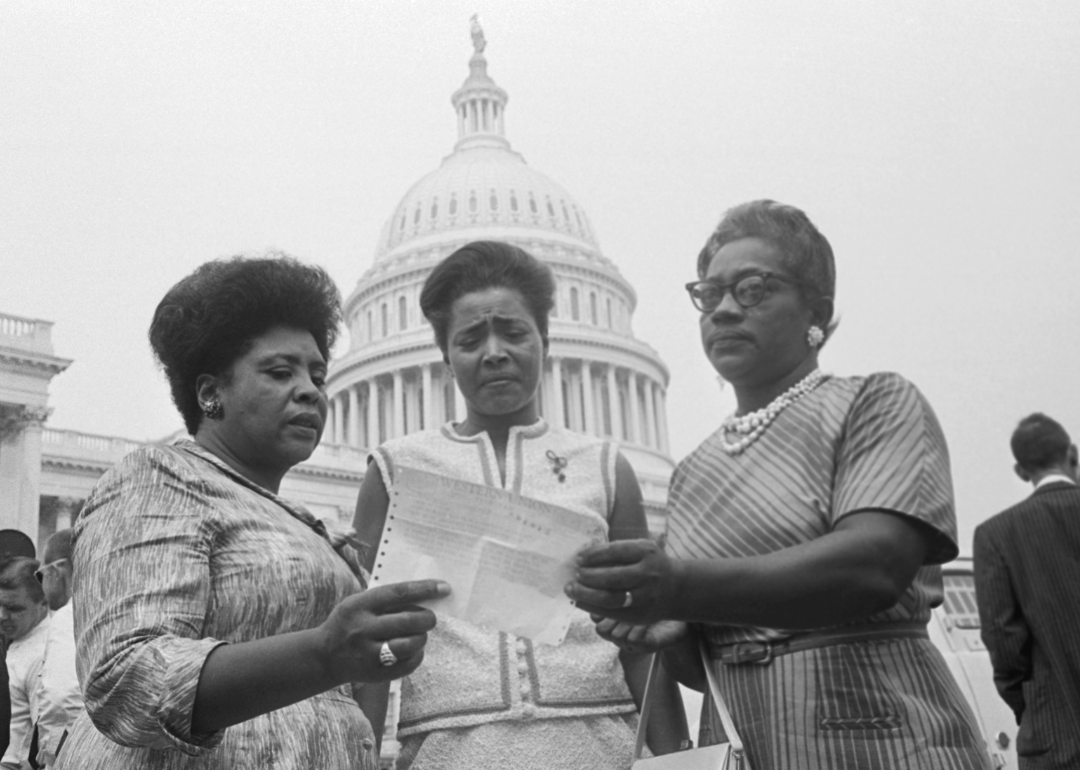
Bettmann Archive // Getty Images
‘Go Tell It On The Mountain’ by Fannie Lou Hamer
Fannie Lou Hamer, Victoria Gray, and Annie Devine on the steps of the U.S. Capitol.
Fannie Lou Hamer was a powerful voice in the Civil Rights Movement. She turned what was typically a traditional Christmas song proclaiming Christ’s birth and reframed it to the issues of the time. Through her application of the song to the struggle of Black people in America, Hamer managed to take the traditional congregational song with the phrase “Let my people go” out of the pews and into the streets. This was part of what scholars refer to as Hamer’s two-fold leadership style using public speeches and sung prayers to inspire her community.
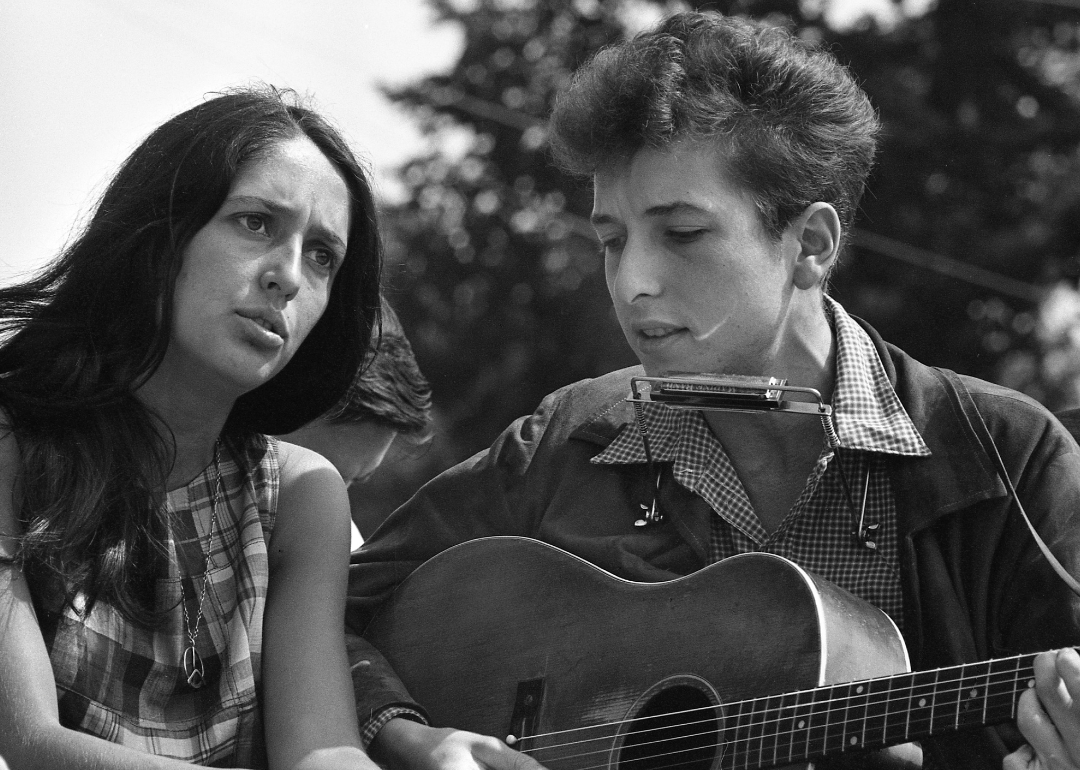
Rowland Scherman // Getty Images
‘Only A Pawn In Their Game’ by Bob Dylan
Joan Baez and Bob Dylan performing in Washington D.C. during the March on Washington civil rights rally.
Two years before the assassination of Malcolm X and five years prior to the assassination of Martin Luther King Jr., Civil Rights leader Medgar Evers was gunned down in the driveway of his home by a Ku Klux Klan member named Byron De La Beckwith VI. “Only a Pawn in Their Game” references Evers directly in the opening line and goes on to posit that white people of lower classes were also manipulated into hateful acts by those in power, thus trying to make a case for justice and solidarity regardless of one’s skin color.
Evers was an integral part of the Civil Rights Movement of the ’60s from the early stages as the field secretary for the NAACP in Mississippi; he was personally responsible for a major push towards voting registration, especially in the South. His death rocked the community and the movement, and his murder went unresolved for nearly 30 years.
Story editing by Carren Jao. Copy editing by Tim Bruns.



